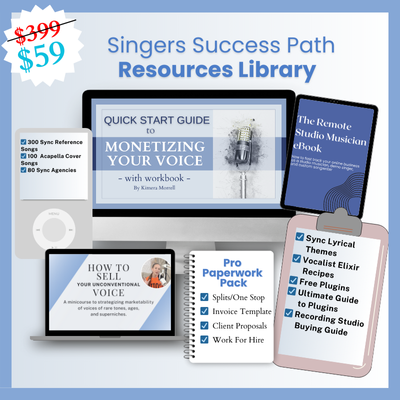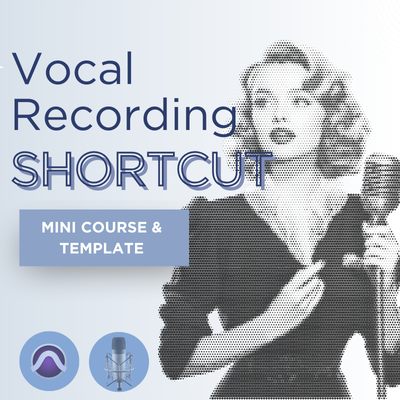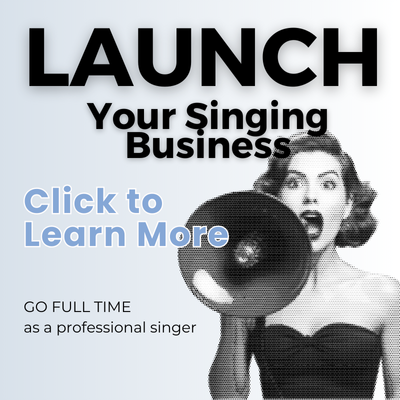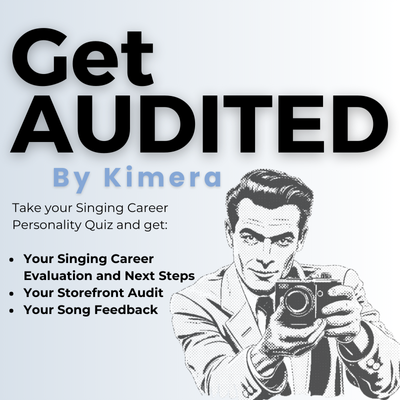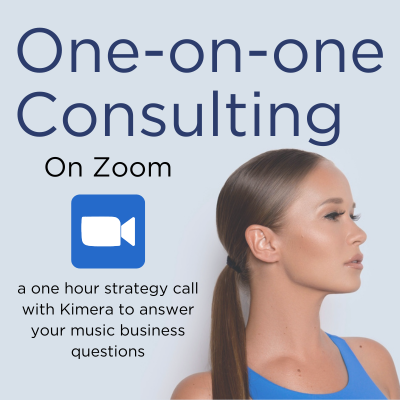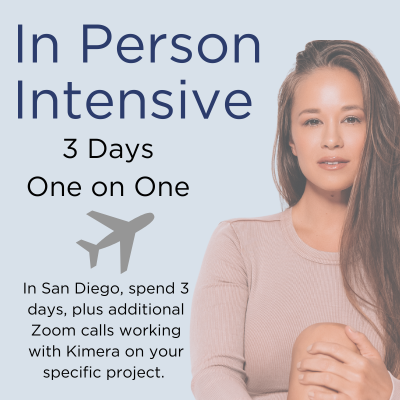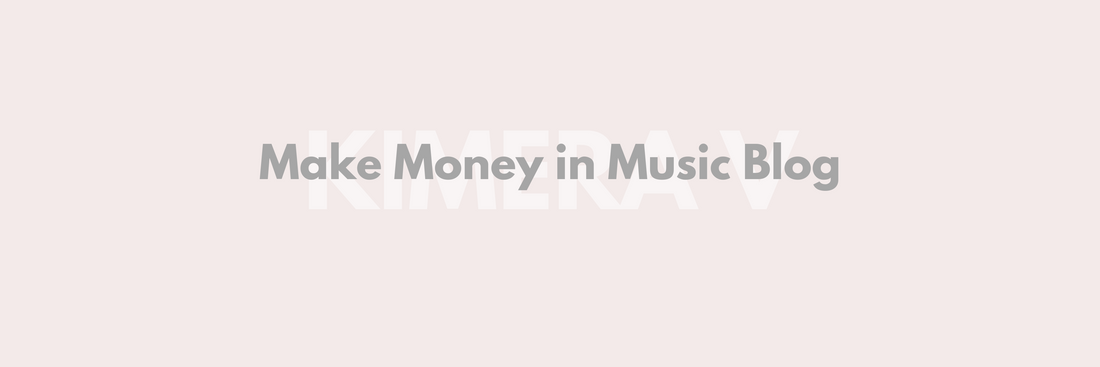
Master List of Music Revenue Streams
Kimera MorrellMaster List of Music Revenue Streams
Download the Full Master List of 35 Ways to Make Money in Music Here
Let’s go in depth on my Top 5 music revenue streams:
- Remote Studio Gigs
- Leasing Acapellas or Beats
- Make a Sample Pack
- Sync Licensing
- Teaching Lessons, but at Scale
1. Remote Studio Gigs
This category is for almost everyone who is awesome at what they do in music and has some kind of recording studio setup. You don’t have to be a world-class engineer, but you do need to be able to produce a professional recording.
This is for:
- Vocalists
- Songwriters
- Producers/Composers
- Mixing Engineers
- Audio Editing and Tuning Experts
- Mastering Engineers
- Musicians of Every Instrument
Quick Start!
Step 1: Set Up Your Profile
- Soundbetter.com: Start by creating your profile on Soundbetter.com, as there is a waitlist. Make sure your profile is pristine—check out the profiles of successful pros for inspiration. Once you're ready, apply for Premium and wait for them to review your profile.
SB is the king of remote studio gigs websites with an unparalleled online presence. Enjoying over six figures a year in studio gigs alone, this site’s highly curated vetting process is a major reason for its success. While anyone can sign up and post their services for free, becoming a Premium Provider is essential to reach their massive clientele. This membership costs $99 per month, and while you don’t get charged until approved, the return on investment can be significant. My approval took about 8 months, but some wait up to a year. The wait and the fee are worth it! Check out my Soundbetter Video Here!
Step 2: Expand Your Reach
- Airgigs and Vocalizr: Copy your profile info to Airgigs and Vocalizr (if you’re a singer). Consider buying an ad on Airgigs and also check out their public job board. On Vocalizr, place numerous bids initially, but then just check back every few days and place a few more.
Airgigs allows you to buy an ad and get immediate visibility without the vetting process. Ensure your profile showcases your best work and includes a compelling bio to earn clients’ trust. For $45, you can boost your visibility to the top of the list in your category, although this visibility typically lasts about a month. The site also features a public job board where you can freely apply to posted jobs. While Airgigs has fewer clients compared to larger platforms, it still offers valuable opportunities. Check out my Airgigs Video Here!
Vocalizr.com sees a good amount of action for vocalists. It is also marketed to producers, but in my opinion, producers are usually the clients, so it might not be a money-making outlet for them. Their format is different: clients post gigs for songwriters/singers to place bids on. This allows the client to view bidders’ profiles and music samples, then award the gig to the bidder of their choice.
- Pros: Singers’ bids and profiles are more likely to be seen by clients, you can request to “connect” with the client, and you can see other bids to scope out the competition.
- Cons: Seeing everyone else’s bids might drive prices down, which can hurt us all in the long run. (Check out my rant about setting prices)
Step 3: Rinse and Repeat
- Explore Other Platforms: Besides Soundbetter, Airgigs, and Vocalizr, there are other platforms where you can offer your services. Don’t forget to create your own website and promote your services to your loyal fanbase. Here are additional gig websites to consider:
- LANDR Network
- Melodynest
- Musiversal
- StudioPros
- Kollab.co
- ProCollabs
- DemoMySong
- Thumbtack
- Upwork
- Fiverr
2. Leasing Acapellas or Beats
Top Marketplaces:
- Beats: The number one marketplace for selling beats is Beatstars.com. Hands down. My friend Cool Typhoon tells us why in this article.
- Acapellas: The top marketplace for selling acapellas is Vokaal.com.
Other Marketplaces
For Beats:
- Airbit
- SoundClick
- TrakTrain
- Soundee
- Soundgine
- Loopmasters
- Soundbetter
For Acapellas:
- Voclio
- Looperman
- Splice
Soap Box Moment
I’m only going to say this once more and leave it alone: YOU CAN SELL ON YOUR OWN WEBSITE WITH EFFORT AND MARKETING (and you should because you’re a boss.. it’s a building process). But you can also capitalize on existing marketplaces for their audience. Yes, you might give a percentage to these sites, but they deserve it. I am so grateful for these websites for giving me the ultimate launchpad to be seen.
Check out my acapella and sample pack store right here for some inspo: https://kimerav.com/pages/vocal-downloads
Beatstars.com
- Pro Membership: Beatstars Pro membership (to sell stuff) is $19.99 a month. They do not take a commission from your sales. You keep 100% of your earnings. Beautiful.
- Getting Seen: Getting seen is the hard part. People get super creative to increase their views and hopefully land on one of the awesome charts. Charting is key.
- For Singers: Beats with hooks are a hot commodity. Surf the charts, listen, like, comment, DM producers you like. Try to collaborate with people. Beatstars has a feature where you can assign a collaborator to a song so everyone gets paid out.
- For Producers: Beats with hooks are a hot commodity. Find ways to set yourself apart. Be incredible—that’s the ultimate key.
- Paid Promotion: Paid promotion is available and I recommend it. But above all, focus on making incredible music.
Vokaal.com
- Experience: Vokaal and Voclio are the only acapella licensing sites I’ve tried, and I’ve been happy! My very first month on Vokaal was about $800 in sales of $39 acapellas. They take a 30% commission, so I make about $30 per acapella.
- What to Know: Vokaal cares deeply about their mission to help singers make a beautiful living. They are transparent with your sales information, encourage you to email your buyers, and are non-exclusive. You are encouraged to post your acapellas everywhere you can to maximize your earnings.
3. Sample Packs
Step 1: Do Your Market Research
- Why: You’ve gotta study what the competition is doing. Notice what’s working for them, and ask yourself: What can you do better?
- How: Start by diving into Splice. Below is my quick reverse engineering strategy, for how I made my latest pack!
Step 2: Search for Similar Creators
- Splice Search: Head over to Splice and search for creators who make similar stuff to you. Download their entire pack—not only are you supporting them, but you’re also doing valuable market research!
- My Example: As a vocalist, Karra is my absolute hero. I downloaded her pack and studied what she created. Check her out at https://iamkarra.com/.
Step 3: Organize Your Plan of Attack
- Analyze: Make a list of the folders in their pack. This is going to be the starting point for your own master plan.
- Customize: Decide what folders you’ll keep, add, or modify to make your pack unique. For example, I noticed that not many other singers had harmonized loops, so I made sure to include those in my pack.
Step 4: Naming and Organizing Your Files
- Pay Attention: Take note of how they name each track. How are you going to name all of your files?
- Create Folders: Build folders and subfolders for the different types of files you’ll have, and keep these in mind for when it’s time to bounce.
Step 5: Start Recording/Producing
- Get to Work: Now it’s time to record! If you’re an instrumentalist or vocalist, you can write to an existing chord progression—but beware of headphone bleed!
- Set Goals: It helps to set target goals for how many samples you’ll create. Sometimes I exceeded my goals (woohoo!) and sometimes I came up short (boohoo!)—but it’s totally fine!
Step 6: Make a Demo
- Demo Time: Create a mini audio commercial showcasing what’s in your pack. Want to hear mine? 😉
Step 7: Sell Baby, Sell!
- Submit to Splice: Splice does take submissions, but be warned—it can take quite a while, and there’s no guarantee you’ll get published.
- Self-Release: For my first pack, I decided to self-release on my own website. I also partnered with non-exclusive websites (who take a percentage) to get the pack out there and rockin' and rollin’!
- Future Goals: I do hope to work with Splice someday though!
Distribution Options
I use Symphonic Music for my distribution, and you can apply to be distributed through them too. They offer a service to distribute sample packs to multiple providers.
Here are the other websites to try:
- Vokaal
- SampleFocus
- LANDR
- Loopmasters
- Samplephonics
4. Sync Licensing
What is Sync Licensing?
Sync licensing, in a nutshell, is the process of synchronizing your music to a visual medium like TV shows, films, or ads. Maximize your potential for placements by adjusting your writing style to fit what sync opportunities usually need. Sync music often follows specific formulas, and by writing music that’s in demand, you increase your chances of landing more placements. Though it does take some finesse (I dive deeper into this topic in my full article on sync), there are three main avenues for getting sync placements:
1. Music Supervisors
- Who They Are: Music supervisors are the people who decide what songs get placed in visual media.
- How to Work with Them: Building relationships with music supervisors can lead to direct placements, without having to share your publishing or split fees with an agent. However, this is often the long game. Unless you’re lucky and have a cousin who’s a music supervisor, forming these connections takes time and effort.
2. Licensing Agencies
- What They Do: Licensing agencies are typically small to medium-sized boutique companies with a team of agents who actively pitch your music for you. They often act as your publisher, keeping 100% of your publishing and splitting 50% of your upfront fees (which can range from $500 to $150,000).
- Why I Like Them: Licensing agencies don’t require you to sign your entire catalog or future works; they sign individual songs or collections. This allows for flexibility and targeted placements.
3. Libraries
- How They Work: Music libraries generally house a large catalog of songs, searchable by music supervisors via parameters like mood, genre, tempo, and more. Libraries tend to offer non-exclusivity, which means you can submit the same song to multiple libraries at once. This is a great option for your back catalog, especially if you’re just getting started with sync.
Why I Choose Agencies
Personally, my favorite route is Licensing Agencies. I like the attention they provide, and they tend to be more proactive in getting me quality placements compared to libraries. They also send me briefs, giving me opportunities to write custom songs tailored to specific shows or ads.
For Your Back Catalog: Try Libraries!
If you’re new to sync, libraries are a great starting point. Many libraries accept submissions and review them all, so don’t hesitate—send them your best songs and see what sticks! Your back catalog could be perfect for background music in scenes like a club or bar.
Music Supervisors: Waste of Time?
If you’re considering submitting directly to music supervisors, I have to say I advise against it. I DO recommend getting to know them, listening to them speak on panels, and learning what you can from them because afterall THEY decide if your song gets used. But they prefer to get their music from Sync Agencies because the music is "pre-cleared" and it saves them time and headache going through the administration side of things with licensing deals.
The Beauty of Licensing
Here’s the fun part about licensing: You’re not selling your song—you’re licensing it, which means you’re granting someone temporary permission to use it for a specific purpose and timeframe. This means that your song could be in a Whiteclaw commercial one month, and in a car commercial the next!
5. Teaching Lessons at Scale
This is probably one of the most popular music revenue streams out there — and for good reason. Teaching has always been a reliable way for musicians to earn money while sharing their craft.
The Way of the Past:
Collaborating with local schools as the friendly neighborhood saxophone teacher, offering private lessons in homes, and traveling from student to student. This traditional model, while effective, has its limitations—primarily in time, effort, and logistics.
The Way of the Future:
Enter the world of digital education! The possibilities are endless when it comes to creating and selling online educational programs. It’s more efficient, you’ll save time (no more driving house-to-house), and most importantly, people are now used to learning via Zoom and other online platforms.
Quick Start Guide:
Step 1: Decide What to Offer
Here are some types of digital educational offerings to consider:
- Write an E-book: Share your expertise on a subject and sell your guide as a digital download.
- Create Short PDFs: Offer extremely specific tips or lesson plans that people can buy and use.
- Film Micro Lessons: Make bite-sized, highly focused videos (around 10 minutes each) on specific techniques or topics. Perfect for students who want quick wins!
- Develop a Full Evergreen Course: Build a more comprehensive course that includes videos, PDFs, sheet music, and more. Once it’s done, students can enroll and access it anytime.
- Offer Live One-on-One Lessons: Teach directly over Zoom, maintaining the personal touch that students appreciate.
- Host Live Group Lessons: These are like leading a class rather than a private session. Great for teaching larger groups at once.
- Create a Larger-Scale Masterclass: Charge a premium rate for an immersive learning experience. This could include a combination of pre-recorded video lessons, live group sessions, and a community element like a private Facebook group or Slack channel.
- Open Consulting Hours via Calendly: Offer general consulting or music coaching sessions and charge by the hour. Perfect for musicians who want advice on their career or other related topics.
Step 2: Do the Thing!
- Create Your Product: Whether it’s a video course, e-book, or set of PDFs, make sure it’s polished. Tools like Canva can help you design attractive resources.
- Set Your Prices: Decide how much you’ll charge based on the depth and quality of your offerings.
Step 3: Sell the Thing!
Selling your digital products can seem overwhelming, but it doesn’t have to be! If you don’t have a website yet, now’s the time to consider it. However, you can start small by taking advantage of existing platforms and marketplaces that specialize in educational content.
- Start Small, Build Gradually: You don’t need to scale the mountain right away. Start at base camp and focus on listing your offerings on platforms like AirGigs (which has a section for micro-lessons) to get exposure.
- Leverage Existing Marketplaces: Here are a few places where you can list your music lessons:
- Soundslice.com
- MusicTeachersNetwork.com
- MusicTeachersDirectory.org
- TakeLessons.com
- HeyTutor.com
- Lessons.com
- Superprof.com
- Guru.com
- You can even branch out into general marketplaces like Fiverr or Thumbtack to find new students. The key is to list your services wherever possible because you never know where your next student will be searching for lessons.
Building Your Educational Business
Building an educational business from the ground up involves some footwork when it comes to marketing. However, you can start by giving people a taste of your teaching style through social media.
Here’s a simple plan to get started:
- Post regularly on social media like TikTok, Instagram, YouTube, and Facebook to build awareness of your offerings and teaching style.
- Create a basic website to showcase your services and start collecting emails for your newsletter.
- Create and list your products/services on the platforms mentioned above, always linking back to your website when possible.
From here, it’s all about slowly expanding your business. Gradually improve your SEO, learn modern marketing techniques, and build up your brand over time.
With consistent effort, you’ll create a profitable educational business, all while helping others on their musical journey.
Conclusion: Your Music, Your Rules
At the end of the day, making a living with your music is all about creating opportunities, not waiting for them. Whether you're diving into sync licensing, teaching the next generation of musicians, selling your vocals as samples, or creating your own products, the sky's the limit when it comes to building a sustainable career on your own terms.
Remember, none of these revenue streams require a label deal or some kind of gatekeeper’s approval. These are all accessible, DIY avenues where you control the narrative. Some may take time to develop, and some may require stepping out of your comfort zone, but every step is a step toward independence and financial freedom.
Grab your free copy of the Master List of 35 Revenue Streams for Singers, and check out the other resources I offer here: https://kimerav.com/pages/singers-success-path
![Master List of Revenue Streams [FREE]](http://kimerav.com/cdn/shop/files/SSP_Resources_Square_1.png?v=1722012080&width=533)
![Vocal Recording Simplified Handbook [FREE]](http://kimerav.com/cdn/shop/files/SSP_Consulting.png?v=1722012447&width=533)
